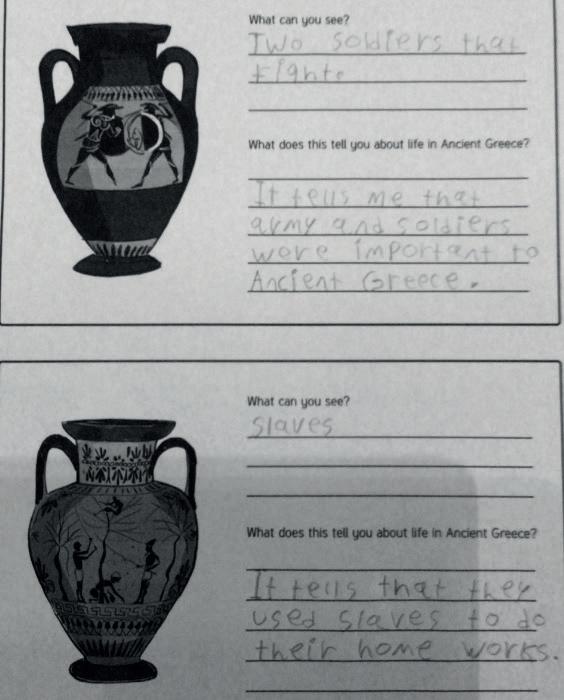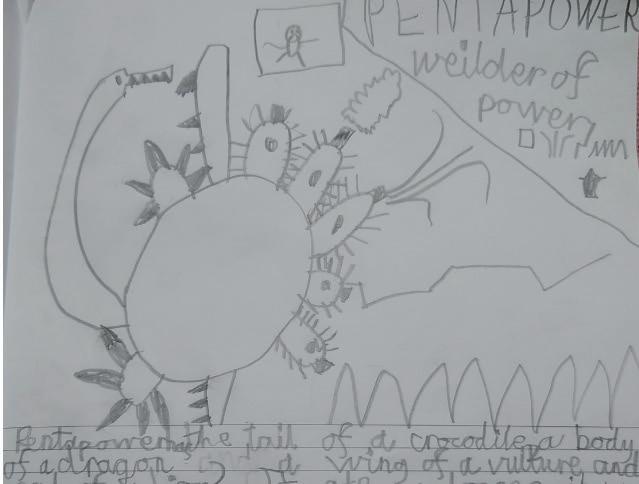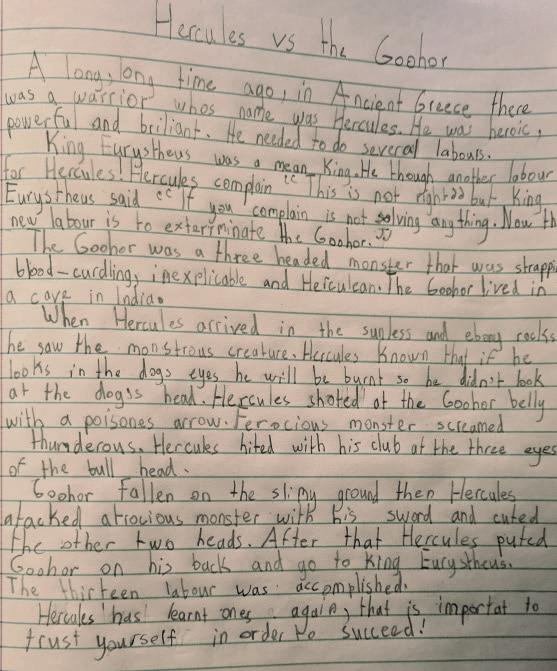
9 minute read
Year 3T
Year 3 - Study Ancient Greek Civilisation
In Term 1B, Year 3 were learning about the Ancient Greek civilisation. In the introductory lessons, we focused on the who, when, and where aspects of this stage of history by looking at maps and timelines to provide more context. It’s really important to begin the study of ancient Greek society with a look at the physical features of Greece and also to generate discussions about archaeology and the study of Greek artefacts, before moving on to look at Ancient Greek life.
Students often wonder ‘How can we possibly know so much about the Ancient Greeks who lived over 2,500 years ago?’ One of the early activities we did required students to look carefully at some Ancient Greek vases for clues in order to make deductions. The answers lay on the decorations painted on the pot! This was a fun and engaging activity, which encouraged ‘higher order thinking skills’, because the students were thinking deeply, laterally, and creatively to make plausible suggestions for what sort of events might have taken place back in Ancient Greek times. Our discussions about archaeology and artefacts really helped students understand how historians have worked out how we can be sure about what life was like there 2,500 years ago.

Wherever possible, we endeavour to plan for cross-curricular topic links between subjects such as literacy, maths, and science. This enables the students to use and apply aspects of learning from one subject to another; it is useful because it helps engage students in their learning, providing a mechanism for us to adapt activities so that all children can make good progress.
The Ancient Greece topic provides some wonderful linking opportunities with literacy because their traditional stories (myths) are so engaging for students. They are full of fascinating characters, including Gods, Goddesses, and heroes; we meet terrifying yet captivating mythological monsters; we follow characters on their adventures and quests; and most stories provide us with moral lessons or explanations of how things work in the real world today. As well as reading and analysing some of the more famous myths like ‘Perseus and Medusa’ and ‘Persephone and the Pomegranate seeds’, we embarked upon some writing activities. After learning about the features of narrative writing, we completed some focused writing on ‘characters’ and ‘settings’. The students really enjoyed reading about the ‘12 Labours of Hercules’ and so their first writing task was to write a recount of the labour ‘Hercules vs the Hydra’, in their own words. I challenged them to use the best descriptive language they could think of to ‘paint a picture with their words’ when they introduced the characters and described the setting.
Ms Alison Tansley
Hercules vs Hydra
“As one of the 12 tasks to become a god Hercule had to kill Hydra. She was a snake with nine heads out of which one was immortal. Hydra lived in Lake Lerna and she lived under water dark cave. In order to kill her, Hercule put a fire in her cave. When she came out Hercule cut her head with a sword but two more appeared. Some of the heads spit fire and some spit magical water that made the enemies fly. More than this, Hydra called upon its friend, huge crab. With the help of his nephew, Iolaus he removed and destroyed with flames Hydra’s heads. The immortal head was buried under a pile of stones and covered with a heavy boulder. Hercule defeated Hydra in the battle and returned to Eurystheus, but victory does not count as he had help from Iolaus.”
Erika Peet recount:

Hercules vs Hydra
“The story is happening in Ancient Greece, a long, long time ago in a time that nobody remembers. There lived a king who asked Hercules to do 12 labours, his second Labour was to kill the Hydra. Hercules took along with him Iolaus who was his nephew. The two of them arrived at the Hydra’s lair, it was living in a swamp and was scarring and terrorising everyone. Hercules was brave and strong and he felt he could defeat the Hydra which was a big scary Monster with nine heads and poisonous drool. Firstly Hercules tried to get the Monster out of his hide by shooting arrows at it, then he tried to grab it. Hercules started attacking the Hydra’s heads but the creature was so strong that it grabbed Hercules by his leg. Then a huge crab appeared snapping its claws. Soon after Hercules killed the crab. With the help of Iolaus Hercules destroyed Eight heads of the monster and finally he chopped of the ninth head and buried it. After he completed his task Hercules went back to the King who told him that because he had help this task will not count, making Hercules angry.”
Next, the students had to create their own mythological monster; this was a task they loved. It was a great opportunity to let their imaginations and creativity run wild and create a fun (mostly gruesome) creature. This creature then featured in a new and original myth that they had to write; a ‘13th’ labour for poor Hercules to complete. They had to come up with a plausible plot and think of how they could make the labour challenging for Hercules. Hercules is an interesting hero because not only is he strong, he was also very clever and cunning. I explained that students could plan intellectual challenges as well as physical ones. The students really impressed me with their creativity, producing great results that showcased their improving literacy skills.
Yasemin Cil recount:


Sofia Matei recount:


Hercules vs the Goohor
“A long, long time ago, in Ancient Greece there was a warrior whose name was Hercules. He was heroic, powerful and brilliant. He needed to do several labours. King Eurystheus was a mean King. He thought another labour for Hercules! Hercules complained “this is not right” but King Eurystheus said “If you complain is not solving anything. Now the new labour is to exterminate the Goohor”.
The Goohor was a three headed monster that was strapping blood-curdling, inexplicable and Herculean. The Goohor lived in a cave in India.
When Hercules arrived in the sunless and ebony rocks, he saw the monstrous creature. Hercules known that if he looks in the dog’s eyes he will be burnt so he didn’t look at the dog’s head. Hercules shot the Goohor belly with a poisones arrow. Feracious monster screamed thunderous. Hercules hit with his club at the three eyes of the bull head.
Goohor had fallen on the slimy ground then Hercules attacked atrocious monster with his sword and cut the other two heads. After that Hercules put Goohor on his back and go to King Eurystheus. The thirteen labour was accomplished. Hercules has learnt once again, that it is important to trust yourself in order to succeed.”
In science, we have been learning about nutrition in the ‘Animals including Humans’ topic. We learned about the ‘healthy plate’; balancing the appropriate amount of fruits and vegetables, protein, carbohydrates, dairy and fats. The students became Hercules’ fitness and lifestyle instructor; they created a ‘healthy plate’ of items for Hercules to eat, as well as planning a fitness workout for him to complete. In Term 1B, all of our lessons took place whilst we were learning online.
It was really important to make sure that the learning resources I used were multi-modal to keep the students engaged. It was also an opportunity to embrace and try out some of the wonderful apps and educational learning platforms that are on offer. So, towards the end of the topic the students tried out FlipGrid; a social discussion video learning platform.
The students really enjoyed videoing themselves, sharing their opinions on which character in the Ancient Greek myths was their favourite and why.
Some of them were very adept at finding some emoji’s and pictures of their character to insert as images alongside them as they recorded. We had some very enthusiastic responses.

When we completed the creative writing task for the ‘Black Sea Schools’ Competition, titled ‘The Imposter’, the Ancient Greek stories had inspired Irene Sanduleasa so much that she used the story of Patroclus dressing up in Achilles’ armour in the Trojan War as the inspiration for her writing. It was really wonderful to see how engaged all the students were about the Ancient Greek topic.

The army thought that they were led by Achilles, since his cousin moved and fought like Achilles, but it was still and impostor. With this impostor who led them, Achilles’ army killed a lot of Trojans. When Hector and Patroclus met in the battlefield, they start to fight but Hector didn’t know he was fighting an impostor.
Only after Hector killed him and he removed the crest, he realised he killed Achilles’ cousin. This fact cost the Trojans the entire war, since Achilles wanted to revenge his cousin death and decided to remain and fight. He killed Hector first and then without their best warrior their prince, the Trojans lost the war. All this because Patroclus made the biggest mistake to pretend he was someone else, tricked Achilles men faking his identity.
This cost the loss of many lives and changed the war’s faith.”
Irene Sanduleasa recount:

“In Greek mythology, Patroclus is the cousin of Achilles. Patroclus is younger than Achilles and he idolised the great warrior. Achilles loved Patroclus very much and even trained him since he was a child to become a great warrior. He taught Patroclus all his skills to move like him, to fight like him, but at the end of each training session Achilles told Patroclus that only he is unique and that Patroclus is kind of an impostor and that he still has a lot to learn.
This is very important element in the story of Trojan war. When the Greeks attacked the Trojans the Greeks knew that their only chance to win was Achilles. After seeing that this war was not good for his people, Achilles decided not to fight and to sail home.
The next day, while Achilles was sleeping his cousin Patroclus took Achilles’ clothes, his sword, his armour and crest and lead Achilles’ little army into battle.










